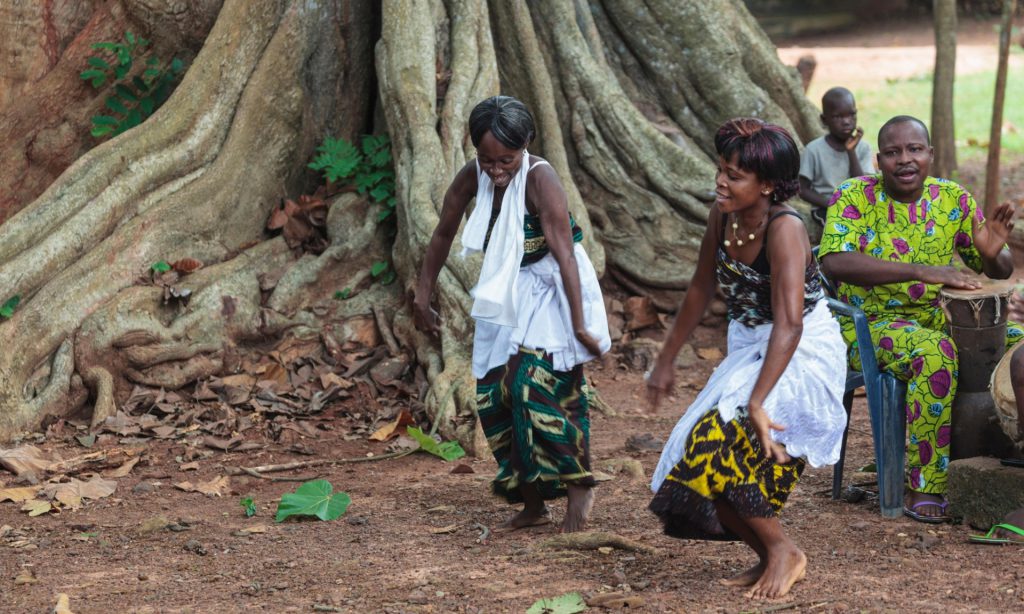Originally posted in the Guardian, 1st July 2015
Benin’s wet tropical forests are full of riches. Ebony, shea and mahogany trees tower over verdant foliage, home to mongoose, warthogs, chameleons. The country’s 3,000 plant species include baobab trees, whose fruit that has six times the vitamin C of an orange and leafy green vegetables rich in iron.
And traditional religious leaders believe that there is more in the forest – sacred spirits and precious medicines that can cure any ailment. The leaves of the kinkeliba bush are eaten for liver problems, bright yellow Cochlospermum planchonii flowers treat female infertility and the sacred garlic pear is used as an antiseptic.
Given the wealth of that store cupboard, it’s clear that there’s a link missing in a country where 12% of households are food insecure and malnourishment is prevalent. Typically, deficiencies are tackled via nutrition programmes that provide supplements or artificially fortified food. But PhD student Flora Chadare is proposing to map the edible plants in Benin’s dense rainforests to prove that they can provide all the vitamins and minerals that people need. “Reports show these plants are high in micronutrients,” says Chadare. “So why not improve the way they are consumed to help nutrition?”
WHO’s current recommendations for combatting malnutrition include fortifying food on an industrial scale, for example, adding vitamin A to flour or iodine to salt. “Food fortification is fine,” says Chadare. “But we have a problem in Africa and in most developing countries: a programme is financed and then it stops. It is not sustainable. These wild edible plants are here already. If the population can learn the right way of using them then it will have a positive impact on nutrition.”
Chadare, who is from Benin and did her PhD at Wageningen University in the Netherlands, was recently awarded $10,000 (£6,300) as second place in the Japanese award for outstanding research for development at the annual Global Development Network conference. “With this money, I can implement the first part,” she says.
Chadare’s plan is to first map five priority indigenous plants that are already known to be highly nutritious and widespread in Benin, examine them in the lab to see the levels of micronutrients, and experiment with combinations to discover the best way to consume them.
“My project is all about how to wisely use edible plants to improve nutritional security in Benin,” she says. “These plants are already eaten in traditional diets, but the combination usually isn’t right. They may be using them but don’t get nutritional benefit from them.”
For example, when you combine vitamin C with iron you enhance the body’s absorption of the mineral, which is essential for healthy blood. Iron from green leafy vegetables is easily available in Benin, but it is not traditionally eaten with vitamin-C-rich baobab. “Why not add a little amount of baobab fruit into the sauce to enhance the iron?” asks Chadare. She says that when the best combinations of food are proven, she will write a policy brief to the government recommending including these plants in Benin’s nutrition strategy. She will also work with local leaders, NGOs and the media so that people can learn what combinations of indigenous food are best.
Carine Nadal at the Gaia Foundation, which works with local NGO Grabe-Benin to protect forests in Benin, says Chadare’s proposal is positive in that it highlights the importance of locally produced food, but she is concerned that plant knowledge isn’t misused, particularly by pharmaceutical companies. “It’s a question of how the research is being done,” says Nadal. “The communities need to discuss among themselves whether they would like to document any of their knowledge, and what kind of knowledge they would want to document.”
Nadal says that approximately 38% of medicinal plants have been lost in Benin due to deforestation. “The main threats are from commercial agriculture and land grabbing by mining,” she says. “Also, the erosion of cultural practices by dominant religions, because communities for centuries have been protecting the forests as part of their traditions.”
Here there has been genuine progress. Last year Benin, the birthplace of voodoo, set a precedent by becoming the first country in Africa to pass a law protecting sacred forests. “This law is among the few in the world to recognise sacred natural sites, and the communities as the custodians who govern and protect these places,” says Nadal. “Other communities in Africa [particularly partners in Ethiopia, South Africa, Kenya, Ghana and Uganda] and elsewhere (Colombia) are drawing inspiration and guidance from it to develop similar laws.”
There is growing international recognition of the role that forests play in food security. A recent report from a UN body says governments need to consider forests as food sources, rather than just areas for conservation. “Forest protection and building the food sovereignty of the community goes hand in hand,” says Nadal.

